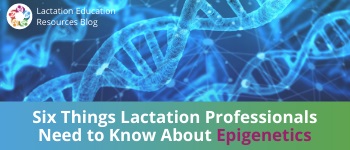Featured
Six Things Lactation Professionals Need to Know About Epigenetics

Six Things Lactation Professionals Need to Know About Epigenetics.
Epigenetics. You’ve heard the word, and you might even have some idea what it means. But did you know that epigenetics and lactation are critically intertwined?
Laurel Wilson, IBCLC, RLC, BSc, CLE, CLD, CCE is a TedX and international perinatal speaker, author, and consultant for perinatal professionals, specializing in epigenetics and human milk. Based on Wilson’s Lactation Education Resources conference “Human Milk: Leaps Beyond Nutrition," here are the top six things you need to know about epigenetics and human milk.
1. What is epigenetics? Epigenetics refers to the field that examines how our environment influences our gene expression.
We’ve all become familiar with the idea that our genes control many aspects of our experience, but there’s sometimes a misperception. We often think that if we possess a gene that codes for a certain outcome, we’re bound to experience that outcome. Not so, says Wilson. Genes can be turned on or off—and the environment flips that switch.
Nutrition, activity level, fitness, immune system health, environment and chemical exposures, and even our thoughts, beliefs, and relationships are all powerful environmental “switch flippers,” with huge effects on whether our genes are turned off or on.
2. What is epigenetic inheritance? It goes one step further. These influences on gene expression can actually be inherited —meaning that an individual’s environment can affect outcomes for their offspring and the offspring of future generations.
Here’s how it works: When an individual is pregnant, their environment is affecting three generations at once—the pregnant individual, the fetus they are carrying, and the ovum or sperm inside that fetus (which impacts the fetus’s offspring). When that environment makes an impact on the fourth generation, however (the fetus’s fetus’s offspring), true epigenetic inheritance has occurred, since that individual was not directly exposed to the environmental variable.
3. How does human milk affect epigenetics? Whether an infant is fed human milk or artificial milk is a key factor in epigenetic outcomes. A human infant’s first food “is designed to be human milk,” Wilson says. “It results in epigenetic expression that sets the stage for health.”
One example of how this works was shown in a 2013 study linking breastmilk or formula feeding with obesity in later life. The study showed that babies fed human milk developed different gut bacteria, which led to very different bacterial metabolites. The type of metabolites directly affected whether genes were silenced or activated—metabolites of formula digestion activated genes for fat accumulation. “This is one proposal of how there could be epigenetic connections with non-species-specific milk promoting disease later on in life,” Wilson explains.
In fact, researchers are discovering more and more ways that the thousands of active components of human milk interact with the epigenome to produce key outcomes in immunity and lifelong disease risks.
4. What about the parent’s epigenetics? Prolactin, vasopressin, oxytocin, and changes in estrogen and progesterone all cause epigenetic changes in the parental brain. This leads to behavioral changes as the brain is rewired with reward pathways for bonding and connection. Research shows that at least 700 separate genes are expressed in the postpartum period due to these changes.
Breast- or chest feeding is critical to the epigenetic process, since it promotes the conditions that cause these gene changes. “Lactating tells the brain that parenting is happening,” Wilson says.
5. What effect does nurturing have on the epigenome? Breast- and chest feeding promote a high-touch style of parenting that also has implications for gene expression. “Holding your baby creates epigenetic changes,” Wilson says.
This was illustrated in a 2017 study that compared the DNA of infants who had been raised with low- and high-contact parenting once they had reached four years of age. The cells of the low-contact infants were much less mature than expected for their age, indicating epigenetic changes.
In an animal study in 2014, researchers subjected pregnant rats to chronic stress. Their offspring showed impaired stress regulation, decreased social interaction, increased anxiety, and learning impairments. However, once they were transferred to foster mothers who provided biological nurturing (licking, nursing), the babies showed repairs in the areas of the brain regulating stress as well as decreased anxiety. Social deficits and learning impairment did not improve, however.
What this shows, according to Wilson, is that the kind of close contact nurturing that occurs naturally during breast- and chest feeding can mend some damages. “Skin to skin and breast- or chest feeding are healing events,” she says. “They can cause epigenetic repair.”
6. What is weathering, and why does it matter?
One last concept is critical for lactation professionals to understand: Epigenetic inheritance provides a mechanism through which historic oppression and inequalities are perpetuated. And understanding this offers an opportunity to change those outcomes.
Through epigenetic inheritance, the effect of environmental conditions and experiences can be passed down through generations. Animal studies have shown this process at work for up to 14 generations, and as the field of epigenetics gets older, researchers have also been able to demonstrate the effect over several generations in humans.
This means that populations that have suffered long term, chronic effects of oppression, marginalization, and racism bear the cumulative marks of those factors in their epigenomes, and this can lead to early health deterioration over time. Epigeneticists refer to this cumulative effect as “weathering” of the epigenome.
Lactation professionals need to recognize that weathering is affecting marginalized communities, and that it starts with infant feeding, according to Wilson.
What can you do? One key role lactation professionals can play is to work to improve systems for milk sharing, Wilson says. Working in your setting to improve donations to donor milk sites and to improve access to human milk for those in need, both through human milk sharing and human milk feeding, can change health outcomes for generations to come.
Ready to learn more? Enroll in Wilson’s conference through Lactation Education Resources

Six Things Lactation Professionals Need to Know About Epigenetics.
Epigenetics. You’ve heard the word, and you might even have some idea what it means. But did you know that epigenetics and lactation are critically intertwined?
Laurel Wilson, IBCLC, RLC, BSc, CLE, CLD, CCE is a TedX and international perinatal speaker, author, and consultant for perinatal professionals, specializing in epigenetics and human milk. Based on Wilson’s Lactation Education Resources conference “Human Milk: Leaps Beyond Nutrition," here are the top six things you need to know about epigenetics and human milk.
1. What is epigenetics? Epigenetics refers to the field that examines how our environment influences our gene expression.
We’ve all become familiar with the idea that our genes control many aspects of our experience, but there’s sometimes a misperception. We often think that if we possess a gene that codes for a certain outcome, we’re bound to experience that outcome. Not so, says Wilson. Genes can be turned on or off—and the environment flips that switch.
Nutrition, activity level, fitness, immune system health, environment and chemical exposures, and even our thoughts, beliefs, and relationships are all powerful environmental “switch flippers,” with huge effects on whether our genes are turned off or on.
2. What is epigenetic inheritance? It goes one step further. These influences on gene expression can actually be inherited —meaning that an individual’s environment can affect outcomes for their offspring and the offspring of future generations.
Here’s how it works: When an individual is pregnant, their environment is affecting three generations at once—the pregnant individual, the fetus they are carrying, and the ovum or sperm inside that fetus (which impacts the fetus’s offspring). When that environment makes an impact on the fourth generation, however (the fetus’s fetus’s offspring), true epigenetic inheritance has occurred, since that individual was not directly exposed to the environmental variable.
3. How does human milk affect epigenetics? Whether an infant is fed human milk or artificial milk is a key factor in epigenetic outcomes. A human infant’s first food “is designed to be human milk,” Wilson says. “It results in epigenetic expression that sets the stage for health.”
One example of how this works was shown in a 2013 study linking breastmilk or formula feeding with obesity in later life. The study showed that babies fed human milk developed different gut bacteria, which led to very different bacterial metabolites. The type of metabolites directly affected whether genes were silenced or activated—metabolites of formula digestion activated genes for fat accumulation. “This is one proposal of how there could be epigenetic connections with non-species-specific milk promoting disease later on in life,” Wilson explains.
In fact, researchers are discovering more and more ways that the thousands of active components of human milk interact with the epigenome to produce key outcomes in immunity and lifelong disease risks.
4. What about the parent’s epigenetics? Prolactin, vasopressin, oxytocin, and changes in estrogen and progesterone all cause epigenetic changes in the parental brain. This leads to behavioral changes as the brain is rewired with reward pathways for bonding and connection. Research shows that at least 700 separate genes are expressed in the postpartum period due to these changes.
Breast- or chest feeding is critical to the epigenetic process, since it promotes the conditions that cause these gene changes. “Lactating tells the brain that parenting is happening,” Wilson says.
5. What effect does nurturing have on the epigenome? Breast- and chest feeding promote a high-touch style of parenting that also has implications for gene expression. “Holding your baby creates epigenetic changes,” Wilson says.
This was illustrated in a 2017 study that compared the DNA of infants who had been raised with low- and high-contact parenting once they had reached four years of age. The cells of the low-contact infants were much less mature than expected for their age, indicating epigenetic changes.
In an animal study in 2014, researchers subjected pregnant rats to chronic stress. Their offspring showed impaired stress regulation, decreased social interaction, increased anxiety, and learning impairments. However, once they were transferred to foster mothers who provided biological nurturing (licking, nursing), the babies showed repairs in the areas of the brain regulating stress as well as decreased anxiety. Social deficits and learning impairment did not improve, however.
What this shows, according to Wilson, is that the kind of close contact nurturing that occurs naturally during breast- and chest feeding can mend some damages. “Skin to skin and breast- or chest feeding are healing events,” she says. “They can cause epigenetic repair.”
6. What is weathering, and why does it matter?
One last concept is critical for lactation professionals to understand: Epigenetic inheritance provides a mechanism through which historic oppression and inequalities are perpetuated. And understanding this offers an opportunity to change those outcomes.
Through epigenetic inheritance, the effect of environmental conditions and experiences can be passed down through generations. Animal studies have shown this process at work for up to 14 generations, and as the field of epigenetics gets older, researchers have also been able to demonstrate the effect over several generations in humans.
This means that populations that have suffered long term, chronic effects of oppression, marginalization, and racism bear the cumulative marks of those factors in their epigenomes, and this can lead to early health deterioration over time. Epigeneticists refer to this cumulative effect as “weathering” of the epigenome.
Lactation professionals need to recognize that weathering is affecting marginalized communities, and that it starts with infant feeding, according to Wilson.
What can you do? One key role lactation professionals can play is to work to improve systems for milk sharing, Wilson says. Working in your setting to improve donations to donor milk sites and to improve access to human milk for those in need, both through human milk sharing and human milk feeding, can change health outcomes for generations to come.
Ready to learn more? Enroll in Wilson’s conference through Lactation Education Resources
By accepting you will be accessing a service provided by a third-party external to https://www.lactationtraining.com/
